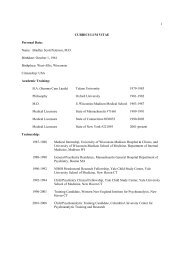Hypothesis testing in mixture regression models - Columbia University
Hypothesis testing in mixture regression models - Columbia University
Hypothesis testing in mixture regression models - Columbia University
You also want an ePaper? Increase the reach of your titles
YUMPU automatically turns print PDFs into web optimized ePapers that Google loves.
12 H.-T. Zhu and H. Zhang<br />
Table 4. Estimates and standard errors of rejection rates for the modified log-likelihood-ratio statistic of a<br />
one-component <strong>mixture</strong> aga<strong>in</strong>st a two-component <strong>mixture</strong><br />
True rate Results (q 2 = 2) for the follow<strong>in</strong>g designs and values of n:<br />
A2 B2 C2 D2<br />
n = 50 n = 100 n = 50 n = 100 n = 50 n = 100 n = 50 n = 100<br />
0.0100 Estimate 0.0166 0.0148 0.2330 0.4843 0.9613 0.9998 0.71650.9611<br />
Standard error 0.0046 0.0029 0.0121 0.01650.0056 0.00050.0159 0.0070<br />
0.0500 Estimate 0.0636 0.0585 0.4459 0.7081 0.9905 0.9999 0.8502 0.9866<br />
Standard error 0.0078 0.0073 0.0141 0.0138 0.0031 0.0002 0.0113 0.0037<br />
0.1000 Estimate 0.1143 0.1078 0.5686 0.8061 0.9960 1.0000 0.9001 0.9923<br />
Standard error 0.0103 0.0102 0.0143 0.0108 0.0019 0.0001 0.0087 0.0024<br />
By <strong>in</strong>spect<strong>in</strong>g Tables 2–4, we f<strong>in</strong>d that the log-likelihood-ratio statistic does not have any<br />
advantage over the modified log-likelihood-ratio statistic. In fact, the opposite seems to be so.<br />
Although we do not have a full explanation yet, the computational complexity could be one of<br />
the reasons. Thus, on the basis of our simulation studies, we prefer to use the modified loglikelihood-ratio<br />
statistic to test hypothesis (5) because of its easier computation and better<br />
power.<br />
3.2. Ames salmonella assay data<br />
We reanalyse an assay data set that has been studied by Wang et al. (1996) among others. The<br />
date set conta<strong>in</strong>s the number of revertant colonies of salmonella under different dose levels<br />
of qu<strong>in</strong>ol<strong>in</strong>e. At each of six dose levels of qu<strong>in</strong>ol<strong>in</strong>e d i , three plates are tested. To fit the data<br />
set, Wang et al. (1996) chose the two-component Poisson <strong>regression</strong> (2) with n = 18, n i = 1 and<br />
Poisson rates<br />
λ i = exp[x T i β + {µ 1U i + µ 2 .1 − U i /}],<br />
where x i = .d i ,log.d i + 10//, i = 1,...,18. They used the Akaike <strong>in</strong>formation criterion and<br />
Bayes <strong>in</strong>formation criterion to facilitate the model selection process, but they did not have a<br />
<strong>test<strong>in</strong>g</strong> procedure to test hypothesis (5).<br />
We use the modified log-likelihood-ratio statistic to test the hypothesis as stated <strong>in</strong> expression<br />
(5). First, we use the EM algorithm to obta<strong>in</strong> . ˆα P , ˆβ P ,ˆµ 1P ,ˆµ 2P / T = .0:723, −0:0013, 0:378,<br />
1:844, 2:382/ T . Next, us<strong>in</strong>g ˆω P and the results <strong>in</strong> Table 6 of Wang et al. (1996), we f<strong>in</strong>d that<br />
MLR n = 12:447. Then, the approximation procedure is repeated J = 10000 times, lead<strong>in</strong>g to<br />
ˆp J = 0:0001. S<strong>in</strong>ce q 2 = 1 <strong>in</strong> this case, the true asymptotic distribution of MLR n is 0:5χ 2 0 +0:5χ2 1 ,<br />
giv<strong>in</strong>g a p-value of 0.0002. Therefore, the data support the <strong>mixture</strong> Poisson <strong>regression</strong> with two<br />
components.<br />
We can also use the log-likelihood-ratio statistic to test the same hypothesis. It follows from<br />
Table6ofWanget al. (1996) that the log-likelihood-ratio statistic LR n = 14:44. Although it is<br />
difficult to compute the true p-value, the approximation procedure gives ˆp 10000 = 0:0004. Further<br />
analyses such as residual analysis and the goodness of fit have been reported <strong>in</strong> Wang et al.<br />
(1996).



